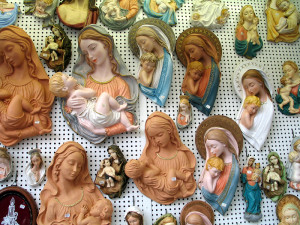 Transpositions hosted a full week (6 – 11 Feb, 2012) of posts all about the relationship between Christianity and Kitsch.
Transpositions hosted a full week (6 – 11 Feb, 2012) of posts all about the relationship between Christianity and Kitsch.
Wikipedia defines kitsch as a “form of art that is considered an inferior, tasteless copy of an extant style of art or a worthless imitation of art of recognized value.” As this quote suggests, kitsch is often defined in opposition to the modern concept of ‘fine art.’ Kitsch is also defined as incorporating parody or sentimentality. Jean Baudrillard mused, that “to the aesthetics of beauty and originality, kitsch opposes its aesthetics of simulation: it everywhere reproduces objects smaller or larger than life; it imitates materials (in plaster, plastic, etc.); it apes forms or combines them discordantly; it repeats fashion without having been part of the experience of fashion” [1]. As such, the concept ‘kitsch’ inevitably carries social, economic and political dimensions.
But why stop there? Kitsch is also loaded with religious and theological import. It is this dimension of kitsch that we explored in our symposium. To do so, we brought together a number of excellent scholars and writers to engage with the subject At the risk of over-sensationalizing a symposium on kitsch, we must say that you, dear reader, will not be disappointed.
- Monday, Feb 6: Betty Spackman, “Wounded for Our Visual Transgressions.” Spackman is the author of A Profound Weakness: Christians and Kitsch.
- Tuesday, Feb 7: Drew Dixon, “Wearing out the Faith.” Dixon writes for Christ and Pop Culture.
- Wednesday, Feb 8: Timothy Gorringe, “Kitsch: Feeling Good about Ourselves while Evil Goes Unchecked.” Gorringe is St Luke’s Professor of Theology at the University of Exeter.
- Thursday, Feb 9: Taylor Worley, “Robert Gober: Troubling the Banal.” Worley is Assistant Professor of Christian Thought and Tradition and Associate Dean for Spiritual Life at Union University.
- Friday, Feb 10: Bex Lewis, “Keep Calm and Pray On.” Lewis is Blended Learning Project Manager, CODEC, St John’s College, University of Durham.
